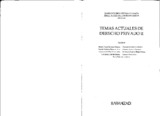Estudio comparado del concepto de obligación civil en Derecho romano y Derecho vigente
Autor
Jiménez Salcedo, Carmen
Editor
AranzadiFecha
2023Materia
ObligacionesCumplimento
Fuentes
Transmisión de las obligaciones
Derecho Romano
Código Civil
Obligations
Extinction
Sources
Transmission of obligations
Roman Law
Civil Code
METS:
Mostrar el registro METSPREMIS:
Mostrar el registro PREMISMetadatos
Mostrar el registro completo del ítemResumen
Es objeto de esta aportación resumir el concepto de obligación, su evo-lución histórica y su régimen jurídico con fin instructivo y didáctico. Por otro lado, se pretende con cada uno de sus epígrafes evidenciar la importancia del Derecho Romano en los estudios de derecho por su influencia directa en nuestro ordenamiento jurídico vigente. A partir del siglo VI el Derecho Romano continúa vivo como referente directo del Derecho común de los pueblos germanas que dominaron Europa hasta que se institucionaliza como Ius Commune europeo a partir del siglo XII y se desarrolla a partir sobre todo del siglo XVI como base del Derecho de los estados europeos. En nuestro actual ordenamiento jurídico la vigencia indirecta del Derecho Romano se manifiesta en multiplicidad de principios y axiomas jurídicos recogidos legislativamente y mencionados en los considerandos de las sentencias de nuestro más alto tribunal. En materia de obligaciones, constatamos esta realidad y nos permitimos mostrar su regulación comparándola con los artículos correspondientes del Código Civil. The purpose of this chapter is to summarize the concept of obligation, its historical evolution and its legal regime for instructive and educational purposes. On the other hand, it is intended with each of its headings to show the importance of Roman Law in law studies by its direct influence on our current legal system. From the sixth century on, Roman Law continued to be a direct reference point for the common law of the Germanic peoples who dominated Europe until it was institutionalized as the European Tus Commune from the twelfth century onwards and developed from the six-teenth century onwards as a basis for Law of European states. In our current legal order, the indirect validity of Roman law manifests itself in a multi-plicity of legal principies and axioms, which have been incorporated into legislation and mentioned in the recitals of the judgments of our highest court. In terms of obligations, we confirm this reality and allow ourselves to show its regulation by comparing it with the corresponding articles of the Civil Code.
Descripción
Embargado hasta 01/01/2100

